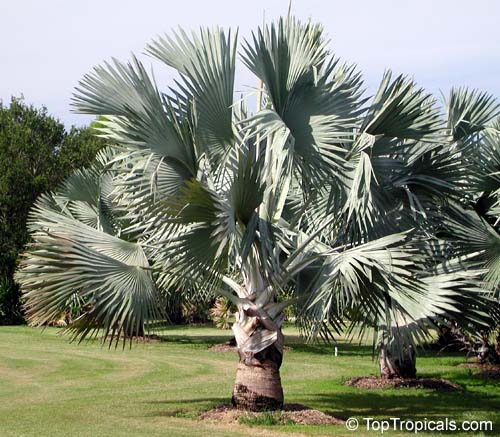Bismarckia
Bismarckia nobilis
The Bismarck palm ( Bismarckia nobilis ) is a native to the savannah of Madagascar palm. It is a large, solitary fan palm. It was named after the German Chancellor Otto von Bismarck.
- 5.1 Notes and references
Features
The Bismarck Palm is a large, tree-shaped, solitary, non-reinforced fan palm. It is dioecious getrenntgeschlechtig ( dioecious ) and more times flourishing. The stem is erect and covered with irregular rings of impermeable leaf scars. The bottom of the tree is expanded.
The number of chromosomes is 2n = 34, 36 and 38
The leaves are folded induplicat and costapalmat, as well as in young individuals after the death of the plant remaining ( Marzeszenz ). In older specimens with trained strain the leaves fall off under their own weight. The leaf sheath is grooved laterally at the base and below the petiole has a striking triangular column. The petiole is strong, grooved on the upper side near the base, distally rather flat; abaxial it is rounded. The surfaces of the petiole are densely covered with white wax and with patches of reddish, sloping shed. The edges of the petiole are smooth. The adaxial Hastula is often very large, the abaxial Hastula missing.
The leaf blade is divided to about one quarter to one third of the length along the adaxial folds there arise such a regular, stiff, easy folded segments. These are short bifid ( two-piece), the filaments between the folds are striking. The surfaces are slightly striated, densely covered with wax. Along the folds sit shed.
Inflorescences
The inflorescences are individually between sheets ( interfoliar ). They are shorter than the leaves, male and female inflorescences are similar. The inflorescence stem is round in cross section. The cover sheet is short, zweikielig and hidden in the vagina of the liner sheet. There are several bracts on the inflorescence stalk, these are Roehrig, rather loose -fitting, and have a wide, triangular, split extension. Their surface is covered with scales and wax. The inflorescence axis is longer than the peduncle. Your bracts are similar to those of the stem, are becoming smaller towards the end. The first-order lateral axes are in the cross-section half-moon shaped and longer than their bracts. You do not have a cover page and branch out on top in a group of three to seven -spaced, kitten -like Rachillae ( flower-bearing axes). Sometimes there are only a Rachilla.
On the male inflorescences the Rachillae are more numerous than in the female. The Rachillae are slightly bent and wearing a tight spiral of plump, hairy, striped bracts. These are laterally fused together and partially connected to the axle, so that pits arise that are densely filled with hair. The female Rachillae are usually more massive than the male. Each of the bracts bears in the armpit a single flower.
Flowers
The male flowers are in slabs to three flowers are surrounded by hair. It appears each one flower per unit time; each has a membranous bract. The cup is Roehrig, membranous, with three short, rather irregular lobes. The crown has a stalk -like base about the length of the sepals, the base supports at the top three oval, hood -like, valvate lobes. The six stamens are at the base of the corolla lobes, the filaments are long, short connected at the base, gradually narrowing. The anthers are Medifix, flexible and latrors. The stamp rudiment is short and conical. The pollen is ellipsoidal and bisymmetrical. The germ is opening a distal sulcus.
The female flowers appear singly on a short hairy stalk, which is greatly extended to fruit ripening. The three sepals are triangular, short fused at the base. The three petals are smaller than the sepals, triangular and short fused at the base. The staminodes are fused with their flattened, triangular filaments and form a ring with three teeth, at the peaks are flat, empty, sagittate anthers. The gynoecium consists of three carpels and is roundish. At the top are three low, slightly recurved scars. There are Septalnektarien available. The ovule is orthotropic with two lateral bodies.
Fruit and seeds
The fruit usually develops from only one carpel. It is ellipsoidal, ovoid or roundish. The scar remains and the abortive carpels are basally. The two abortive carpels enlarge frequently and form two swelling. The exocarp is smooth, shiny, brown with lighter spots. The mesocarp is fibrous, slightly aromatic, the endocarp is thick, with irregular edges and pits and a central invagination at the base. The seed is located basal endosperm is homogeneous, but furrowed to follow the Endokarpeinstülpungen. The embryo is located apically.
Dissemination
The Bismarck palm is endemic to Madagascar. It grows here as a striking element of the savannas in the western part of the island.
System
The genus Bismarckia is placed in the subfamily Coryphoideae, Tribe and subtribe Borasseae Hyphaeninae within the family Arecaceae. The genus is monotypic, it consists of a single type Bismarckia nobilis. Their sister group is Satranala.
In the World Checklist of Selected Plant Families of the Royal Botanic Gardens, Kew, just the way Bismarckia nobilis is recognized.
Bismarckia was first described by Johann Maria Hildebrandt and Hermann Wendland 1881 type species is Bismarckia nobilis Hildebrandt & H. Wendl.
Use
In Madagascar, the tribe of the Bismarck palm is wholly or split used in house construction, the leaves are used for thatching. The Mark of the tribes provides a rather bitter sago. The stem is sometimes tapped for the production of wine. Outside Madagascar, the Bismarck palm tree in the drier tropics and subtropics is a popular ornamental plant.
Documents
- John Dransfield, Natalie W. Uhl, Conny B. Asmussen, William J. Baker, Madeline M. Harley, Carl E. Lewis: Genera palmarum. The Evolution and Classification of Palms. Second edition, Royal Botanic Gardens, Kew 2008, ISBN 978-1-84246-182-2, pp. 309-312.

.jpg)







